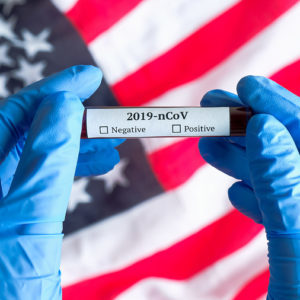The Bucks County health services director said Thursday the county has yet to see any spike in new coronavirus cases from large rallies and protests in the area over the George Floyd killing in Minneapolis.
“We have not had anyone who went to a protest and then came home sick from that protest,” Dr. David Damsker said at a news conference.
“We are asking people that question in our contact tracing. Of course, not everyone may tell us the truth all the time, and we can’t avoid that. But we don’t believe that we’ve seen — that we know of — any cases directly related to exposure from these protests.”
Just the previous week, Damsker said essentially the same thing, but with the caveat that more time would be needed. Now another week has passed, and the county still does not have evidence of a spike.
“This [protesting] is something people felt like they had to do,” Damsker said last week. “We allowed people to [go to] those protests.”
“And if we find that there’s not a lot of spread — or any spread — [because of] people wearing masks and people paying attention to that, that’s really good,” he said. “We know that information, that will help us moving forward.”
For businesses desperate to hear their registers ring, the findings could be a line of evidence in favor of a faster reopening when mask-wearing is part of the equation.
On June 1 in Doylestown, for example, “hundreds of people marched and chanted in support of justice in the death of George Floyd,” according to one media report. Video of the event on Twitter showed widespread mask usage even though most of the protesters were not socially distanced.
Protestors in Doylestown are calling for police officers here to take a knee with them. #JusticeForGeorgeFloyd pic.twitter.com/97VlKVUahQ
— Hayden Mitman (@HaydenMitman) June 1, 2020
As the techniques of how to battle the coronavirus have become politicized, Damsker is a voice who can appeal to both “red” and “blue” political persuasions. He currently is an advocate of mask-wearing as a legitimate method of slowing the spread of the virus.
But in April and May, he was among the few government voices in the Delaware Valley saying the economy could be reopened much sooner.
The county commissioners used his data analysis when publicly breaking with Gov. Tom Wolf to argue the county was ready to begin going back to work. The board of commissioners, controlled by a 2-1 Democratic majority, was also challenging the leader of their party when Wolf was under heavy fire from Republican lawmakers to reopen.
When Delaware and Chester counties made the same argument, the pressure appeared to sway Wolf, who moved all of the Delaware Valley counties into the “yellow” reopening phase far sooner than anyone previously expected.
Bucks has been aggressive not only in the interpretation of its COVID-19 data, but in its gathering, too.
“Bucks County has been a leader [contact tracing] in the Philadelphia region, tracking about 95 [percent] of its COVID-19 cases with a team of about a dozen health department employees who were reassigned from other jobs during the pandemic,” the Inquirer noted in a report from early June.
According to a state database showing infection rates, Bucks has fewer cases per capita than any of its adjacent neighbors.
Last week, Damsker touted the cases of two hairstylists in Missouri who went back to work sick with COVID-19, exposing an estimated 140 customers who were in close contact with the stylists for at least 30 minutes a piece.
“They cut people’s hair while they were symptomatic, but they were both wearing masks,” Damsker said last week. “And the people were also wearing masks who were getting their haircut. And they tested a bunch of people after that and none of them came back positive. So, again, that’s something we didn’t want to happen. But now that it happened, we can take something good out of it.”
Those two cases were recently profiled in the Washington Post, highlighting how the experience changed the mind of the county health director where the stylists worked.
And in some cases, the lessons from those experiences are leading to increased economic activity.
“The city [of Springfield, Missouri] announced that businesses that couldn’t comply with the Centers for Disease Control and Prevention’s recommended six feet for social distancing could instead allow for three feet between people as long as they were wearing a mask,” the Post reported.


